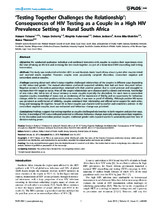| dc.contributor.author | Tabana, Hanani | |
| dc.contributor.author | Doherty, Tanya | |
| dc.contributor.author | Jackson, Debra | |
| dc.contributor.author | Rubenson, Birgitta | |
| dc.contributor.author | Ekström, Anna Mia | |
| dc.contributor.author | Thorson, Anna | |
| dc.date.accessioned | 2017-06-29T08:22:44Z | |
| dc.date.available | 2017-06-29T08:22:44Z | |
| dc.date.issued | 2013 | |
| dc.identifier.citation | Tabana, H. et al. (2013). Testing together challenges the relationship': Consequences of HIV Testing as a couple in a High HIV prevalence setting in Rural South Africa. Plos One, 8 (6): 1-8 | en_US |
| dc.identifier.issn | 1932-6203 | |
| dc.identifier.uri | http://hdl.handle.net/10566/3016 | |
| dc.description.abstract | OBJECTIVE: We conducted qualitative individual and combined interviews with couples to explore their experiences since
the time of taking an HIV test and receiving the test result together, as part of a home-based HIV counselling and testing
intervention.
METHODS: This study was conducted in October 2011 in rural KwaZulu-Natal, South Africa, about 2 years after couples tested
and received results together. Fourteen couples were purposively sampled: discordant, concordant negative and
concordant positive couples.
FINDINGS: Learning about each other’s status together challenged relationships of the couples in different ways depending
on HIV status and gender. The mutual information confirmed suspected infidelity that had not been discussed before.
Negative women in discordant partnerships remained with their positive partner due to social pressure and struggled to
maintain their HIV negative status. Most of the couple relationships were characterized by silence and mistrust. Knowledge
of sero-status also led to loss of sexual intimacy in some couples especially the discordant. For most men in concordant
negative couples, knowledge of status was an awakening of the importance of fidelity and an opportunity for behaviour
change, while for concordant positive and discordant couples, it was seen as proof of infidelity. Although positive HIV status
was perceived as confirmation of infidelity, couples continued their relationship and offered some support for each other,
living and managing life together. Sexual life in these couples was characterized by conflict and sometimes violence. In the
concordant negative couples, trust was enhanced and behaviour change was promised.
CONCLUSIONS: Findings suggest that testing together as couples challenged relationships in both negative and positive ways.
Further, knowledge of HIV status indicated potential to influence behaviour change especially among concordant negatives.
In the discordant and concordant positive couples, traditional gender roles exposed women’s vulnerability and their lack of
decision-making power. | en_US |
| dc.language.iso | en | en_US |
| dc.publisher | Public Library of Science | en_US |
| dc.rights | Copyright Authors. This is an open-access article distributed under the terms of the Creative Commons Attribution License, which permits unrestricted use, distribution, and reproduction in any medium, provided the original author and source are credited. | |
| dc.source.uri | http://dx.doi.org/10.1371/journal.pone.0066390 | |
| dc.subject | Testing together | en_US |
| dc.subject | HIV testing | en_US |
| dc.subject | High HIV prevalence setting | en_US |
| dc.subject | South Africa | en_US |
| dc.subject | Couples | en_US |
| dc.subject | Relationship challenge | en_US |
| dc.title | Testing together challenges the relationship': Consequences of HIV Testing as a couple in a High HIV prevalence setting in Rural South Africa | en_US |
| dc.type | Article | en_US |
| dc.description.accreditation | Department of HE and Training approved list | |

